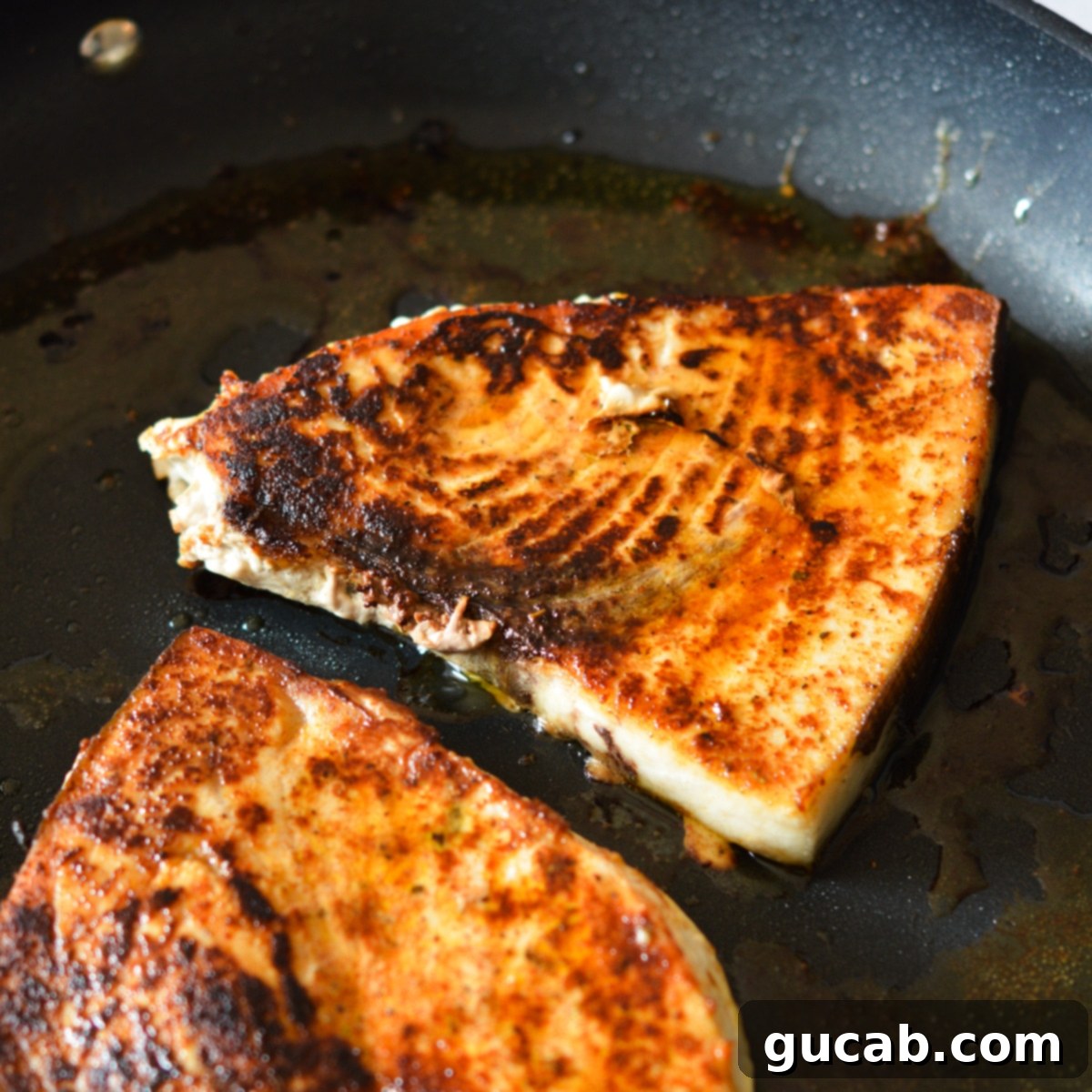Pan-Seared Blackened Swordfish with Cajun Butter: Your Flavorful 20-Minute Dinner Solution
Prepare to elevate your weeknight meals with this incredible **Blackened Swordfish** recipe. Imagine succulent swordfish steaks, perfectly seasoned and pan-seared to create a beautiful, crispy crust, then finished in the oven for ultimate tenderness. The crowning glory? A luxurious, zesty Cajun butter that melts over the hot fish, infusing every bite with rich, bold flavor. This impressive dish comes together in less than 20 minutes, making it an ideal choice for a quick yet gourmet dinner.
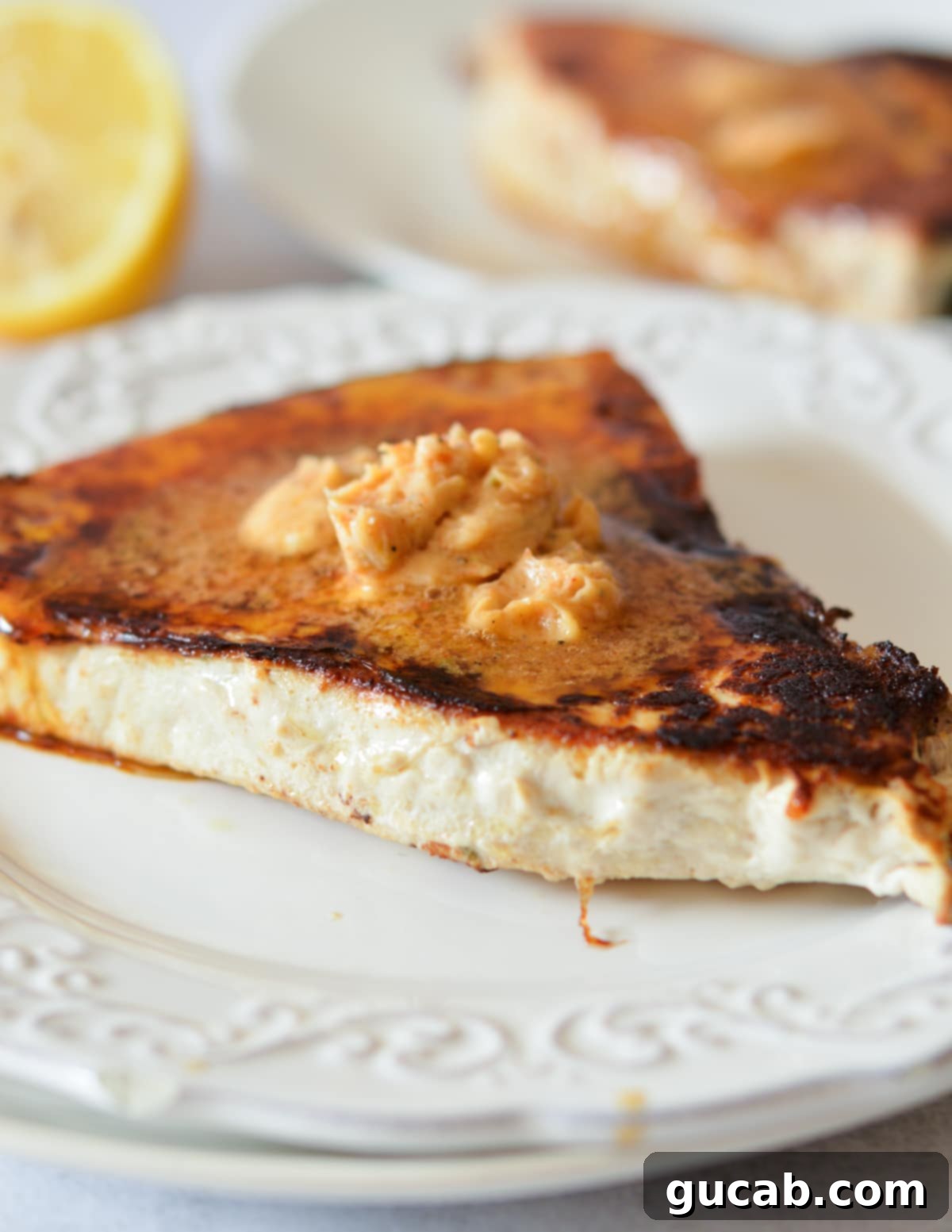
Why You’ll Absolutely Love This Blackened Swordfish
Swordfish is a truly remarkable fish, celebrated for its firm, meaty texture and mild flavor profile, making it incredibly versatile for various cooking methods. This particular blackened preparation, however, takes it to a whole new level of deliciousness. Here’s why this recipe will become a new favorite in your kitchen:
- Lightning-Fast Preparation: From start to finish, you can have a restaurant-quality meal on your table in under 20 minutes. It’s perfect for busy weeknights when you crave something special without spending hours in the kitchen.
- Explosion of Flavor: The blackening spice blend creates a deeply savory, slightly smoky, and wonderfully spicy crust. Paired with the vibrant, herb-infused Cajun butter, each bite is a symphony of flavors that will tantalize your taste buds.
- Perfect Texture: Our two-step cooking method—pan-searing followed by a quick bake—ensures a flawlessly crispy exterior while keeping the inside incredibly moist and flaky. No dry fish here!
- Healthy & Wholesome: Swordfish is a fantastic source of lean protein, omega-3 fatty acids, and essential vitamins and minerals. Enjoy a flavorful meal that’s also good for you.
- Effortlessly Elegant: Despite its quick cooking time, blackened swordfish with Cajun butter looks and feels like a gourmet dish. It’s impressive enough for entertaining but simple enough for a casual family dinner.
- Easy to Scale: This recipe serves two, making it ideal for a romantic dinner or a small meal. However, it’s incredibly easy to double or triple the ingredients to feed a larger crowd without compromising on quality or cooking time.
If you’re already a fan of bold flavors in seafood, you might also enjoy my oven-baked swordfish with lemon basil butter, which offers a different yet equally delicious take on this magnificent fish.
Key Ingredients for Success
Crafting the perfect blackened swordfish relies on a few simple, high-quality ingredients. Each plays a crucial role in developing the rich flavors and textures that define this dish:

- Swordfish Steaks: The star of our dish! You can opt for fresh or frozen swordfish steaks or select cuts. If using frozen, ensure they are fully thawed before cooking (more on this below). Look for steaks that are about 1-inch thick for optimal cooking time and texture. Thinner steaks will cook quicker, so adjust your cooking time accordingly to prevent overcooking, which can lead to a dry, tough result.
- Olive Oil: Essential for achieving that beautiful, golden-brown caramelization and crispy exterior when pan-searing. Use a good quality extra virgin olive oil for best flavor. Its higher smoke point compared to butter alone makes it ideal for the initial high-heat sear, adding a subtle fruitiness that complements the fish.
- The Spice Blend: This is where the “blackened” magic happens! Our blend features:
- Paprika: Provides a rich color and a slightly sweet, smoky flavor.
- Salt & Pepper: The fundamental seasonings to enhance all other flavors.
- Cayenne Pepper: Brings the heat! Adjust to your preference for a milder or spicier kick.
- Dried Oregano: Adds an earthy, aromatic depth.
- Onion Powder & Garlic Powder: Offer a savory base without the moisture of fresh aromatics, contributing to the dry rub.
If you prefer, a pre-made Cajun or Blackening spice mix can be used as a convenient substitute. Just be mindful of its salt content!
- Unsalted Butter (for Cajun Butter): Softened unsalted butter is crucial for creating the luscious Cajun compound butter. It adds a decadent richness and carries the flavors of the spices and lemon beautifully, melting into a flavorful sauce over the hot fish. Using unsalted butter allows you to control the overall saltiness of the dish.
- Fresh Lemon: A squeeze of fresh lemon juice and a hint of zest are vital for brightening up the bold, savory flavors of the blackened swordfish and Cajun butter. The acidity cuts through the richness, creating a perfectly balanced taste. Always opt for fresh lemons over bottled juice for superior flavor and aroma.

How to Properly Thaw Frozen Swordfish
Properly thawing frozen fish is key to ensuring it cooks evenly, retains its best texture, and is safe to eat. Never, under any circumstances, thaw frozen swordfish in hot water. This will partially cook the outer layers, resulting in a rubbery, unpleasant texture, and can also promote bacterial growth, making it unsafe.
Here are two safe and effective ways to thaw your swordfish steaks:
- In the Fridge (Overnight Method): This is the simplest and safest method. The night before you plan to make your blackened swordfish, transfer the frozen steaks from the freezer to a plate or shallow dish in your refrigerator. Allow them to thaw slowly overnight. This method ensures even thawing and maintains the best possible texture. It requires a little foresight but is almost entirely hands-off.
- In Cold Water (Quick Method): If you’re short on time, this method works wonderfully. Fill a large bowl with cold tap water. If your swordfish steaks are vacuum-sealed, you can place them directly into the bowl. If they are not vacuum-sealed, place them in a clean, resealable plastic bag first to prevent water from coming into contact with the fish. Submerge the sealed fish in the cold water. Change the water every 30 minutes to keep it cold. Depending on the thickness of your steaks, they should thaw in approximately 30-60 minutes.
Once thawed, always pat the fish dry thoroughly before seasoning and cooking.
How to Make Perfect Blackened Swordfish: Step-by-Step Guide
My method for creating perfectly blackened swordfish is incredibly efficient, delivering maximum flavor and a fantastic texture with minimal fuss. The process is simple: season, pan-sear, and bake. Follow these steps for an unforgettable seafood dinner:
Before you begin, preheat your oven to 350°F (175°C) and place a 12-inch oven-safe skillet (cast iron or heavy-bottomed nonstick works best) over medium-high heat on your stovetop.
1. Dry the Swordfish Thoroughly
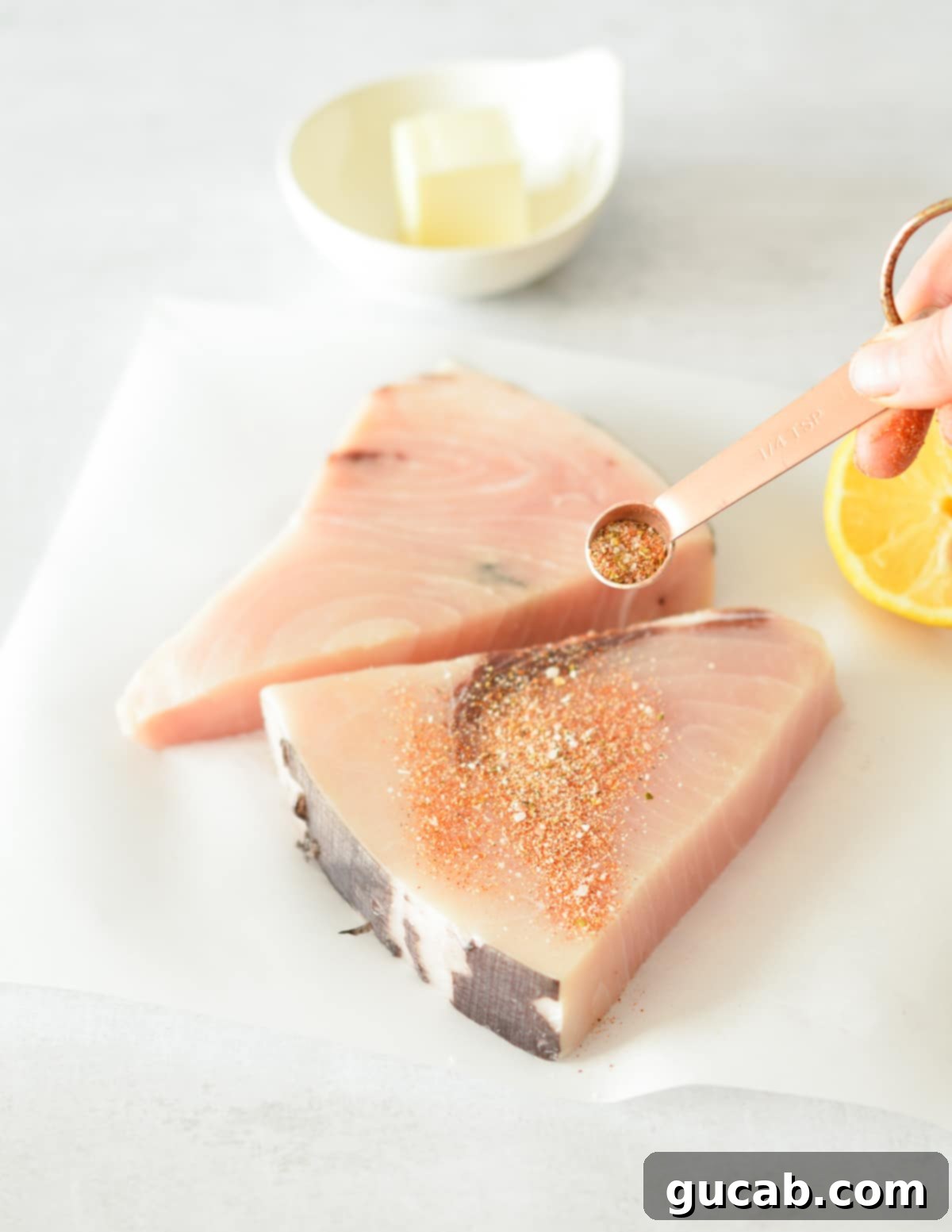
Using paper towels, meticulously pat down both sides of your swordfish steaks until they are as dry as possible. This step is crucial! Excess moisture on the surface of the fish will create steam when it hits the hot pan, which prevents the formation of that desirable deep, golden-brown crust (the Maillard reaction) and a truly “blackened” effect.
2. Season Generously
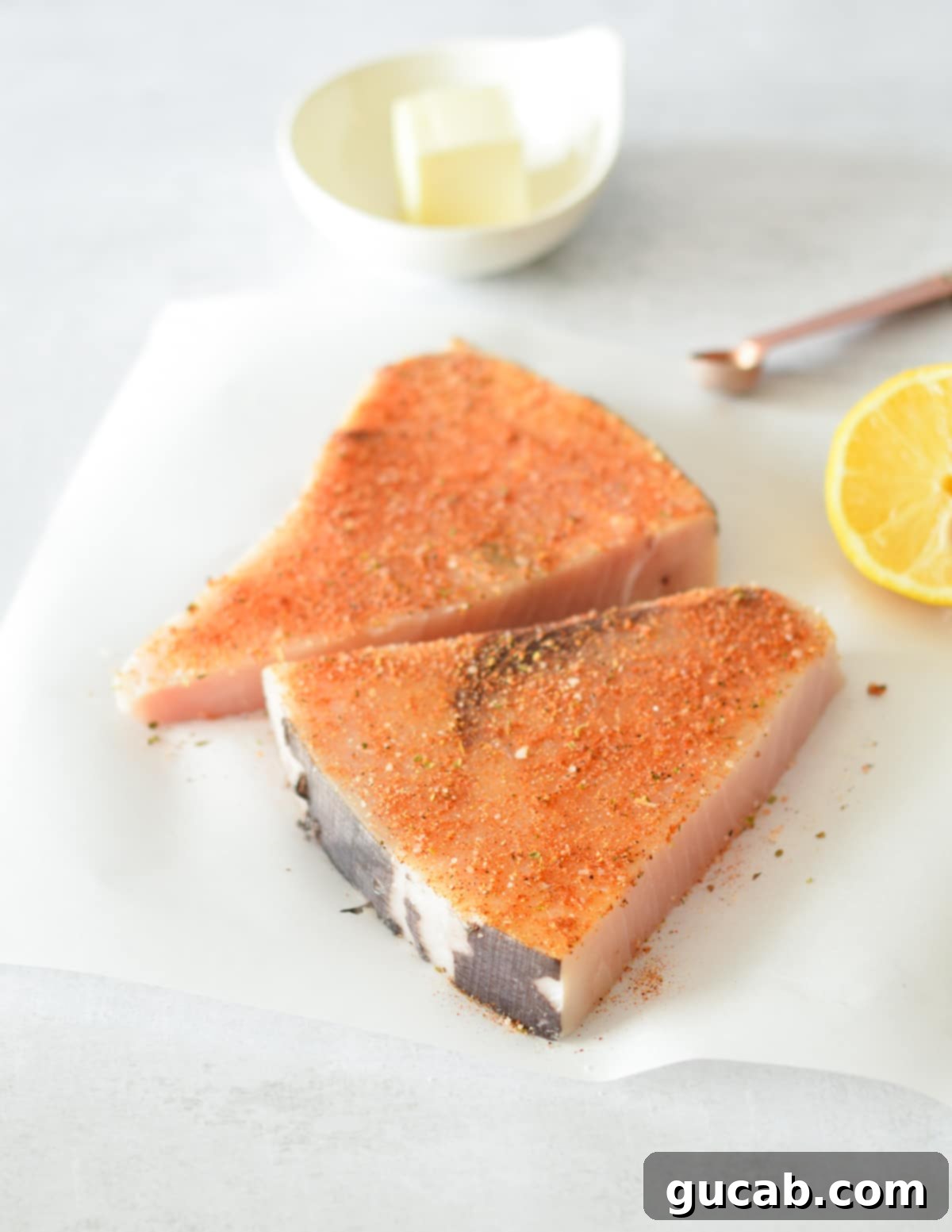
In a small bowl, combine all your chosen spices: paprika, salt, pepper, cayenne, oregano, onion powder, and garlic powder. Mix them well to ensure an even distribution. Take about ¼ teaspoon of this spice mixture and generously sprinkle it over one side of each swordfish steak, making sure to coat the entire surface. Gently press the seasoning into the fish to help it adhere.
3. Pan-Sear for the Perfect Crust
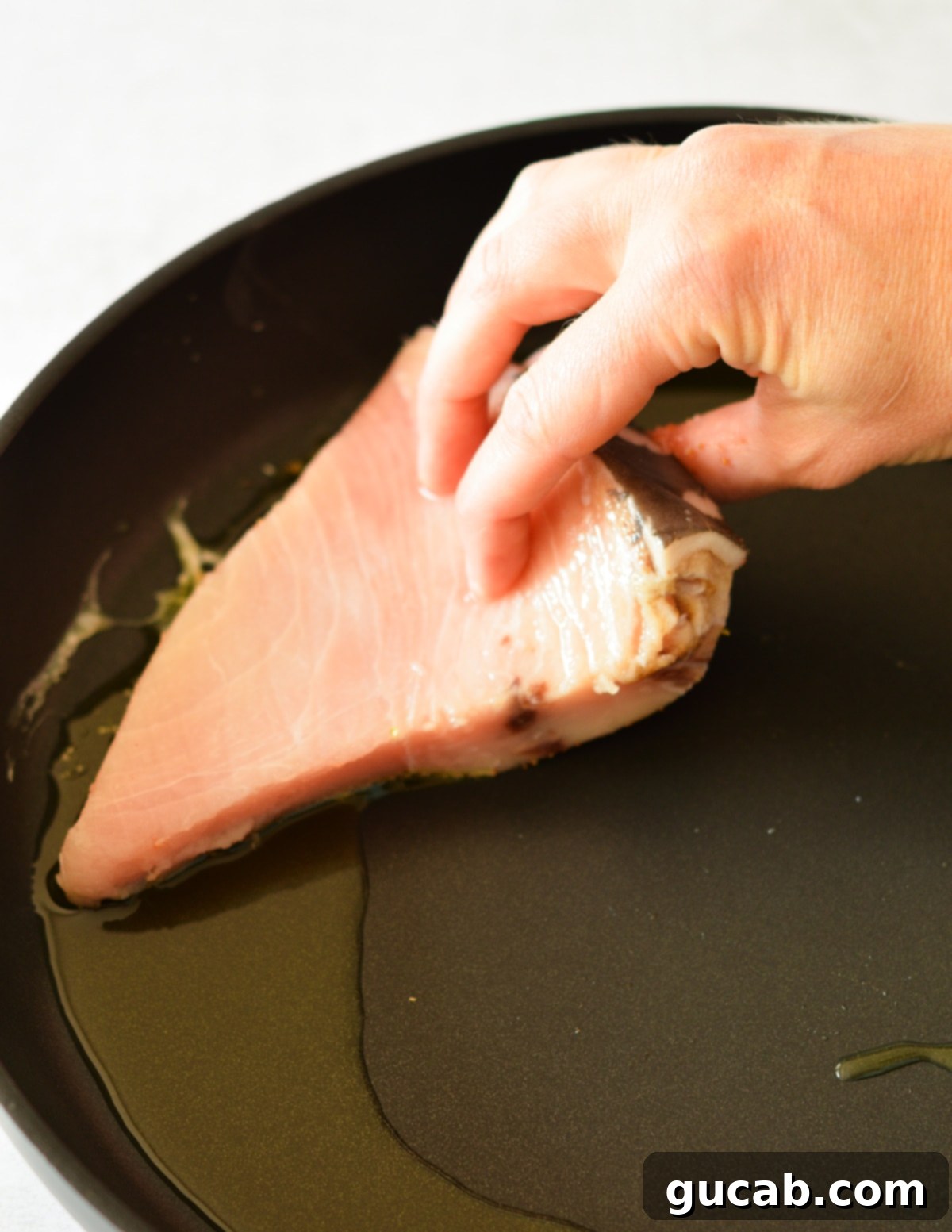
Once your skillet is sizzling hot (a drop of water should evaporate instantly), add the olive oil. Carefully place each swordfish steak, seasoned side down, into the hot skillet. It’s important to do this gently to avoid splashing hot oil. Let the steaks sear undisturbed for 5 minutes. Resist the urge to move or peek at them! This dedicated contact time with the hot surface is what builds that incredible caramelized, blackened crust. You’ll hear a satisfying sizzle, which is exactly what you want.
4. Finish in the Oven

After 5 minutes, use a thin-set spatula to carefully turn each steak over. You should see a beautifully caramelized, deep brown crust. Immediately transfer the entire skillet, with the swordfish steaks still inside, into your preheated oven. Bake for 8 to 10 minutes. The exact cooking time will depend largely on the thickness of your swordfish steaks. The fish is done when it’s opaque throughout and flakes easily with a fork. For a medium-cooked swordfish, the internal temperature should reach around 130°F (54°C).
5. Prepare the Homemade Cajun Butter
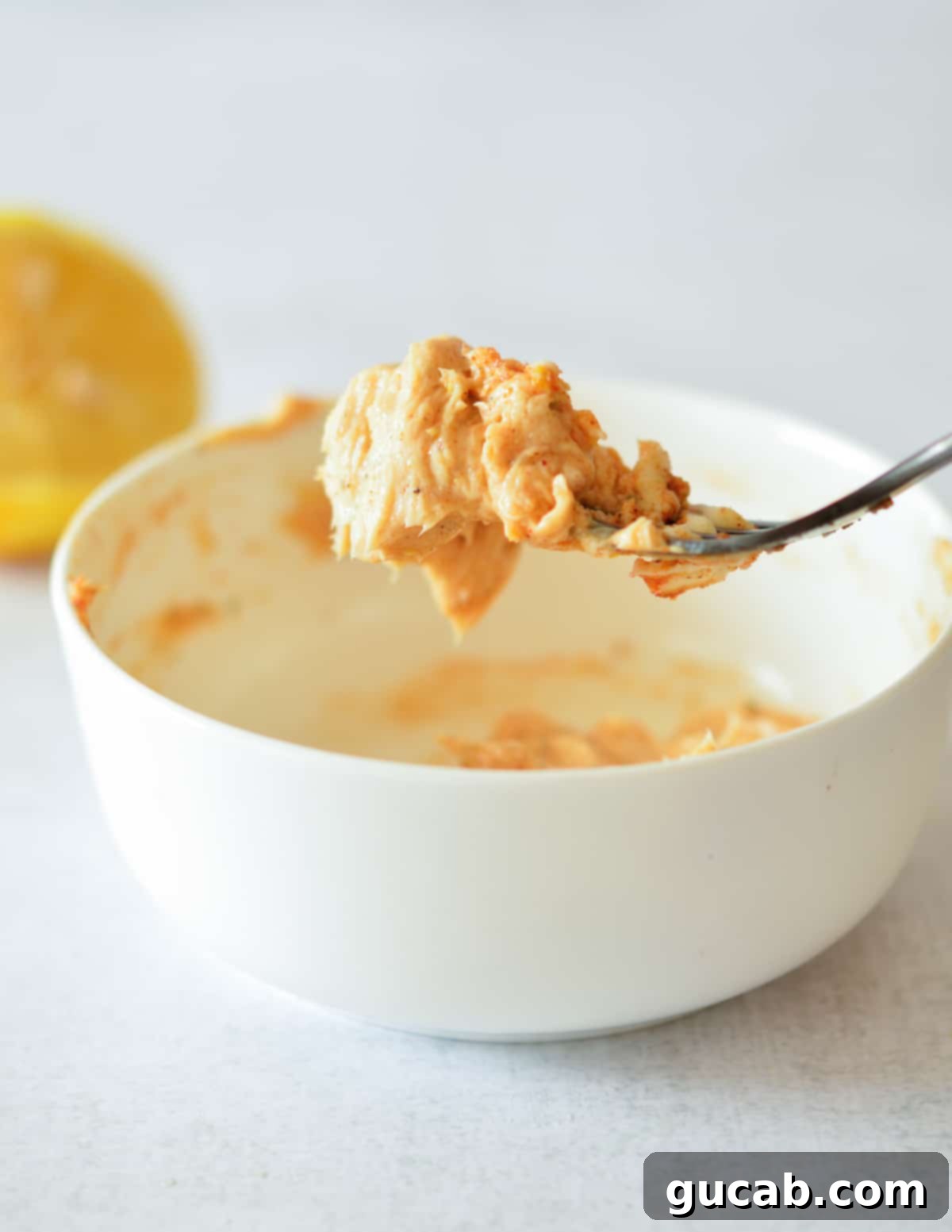
While the swordfish is baking, prepare your delicious Cajun butter. In a medium bowl, combine the softened unsalted butter with the remaining portion of your spice mixture, the fresh lemon zest, and the lemon juice. Use a fork to mash and mix everything together until it’s well combined and creamy. This compound butter will melt beautifully over the hot fish, adding a burst of flavor and moisture.
6. Serve Immediately
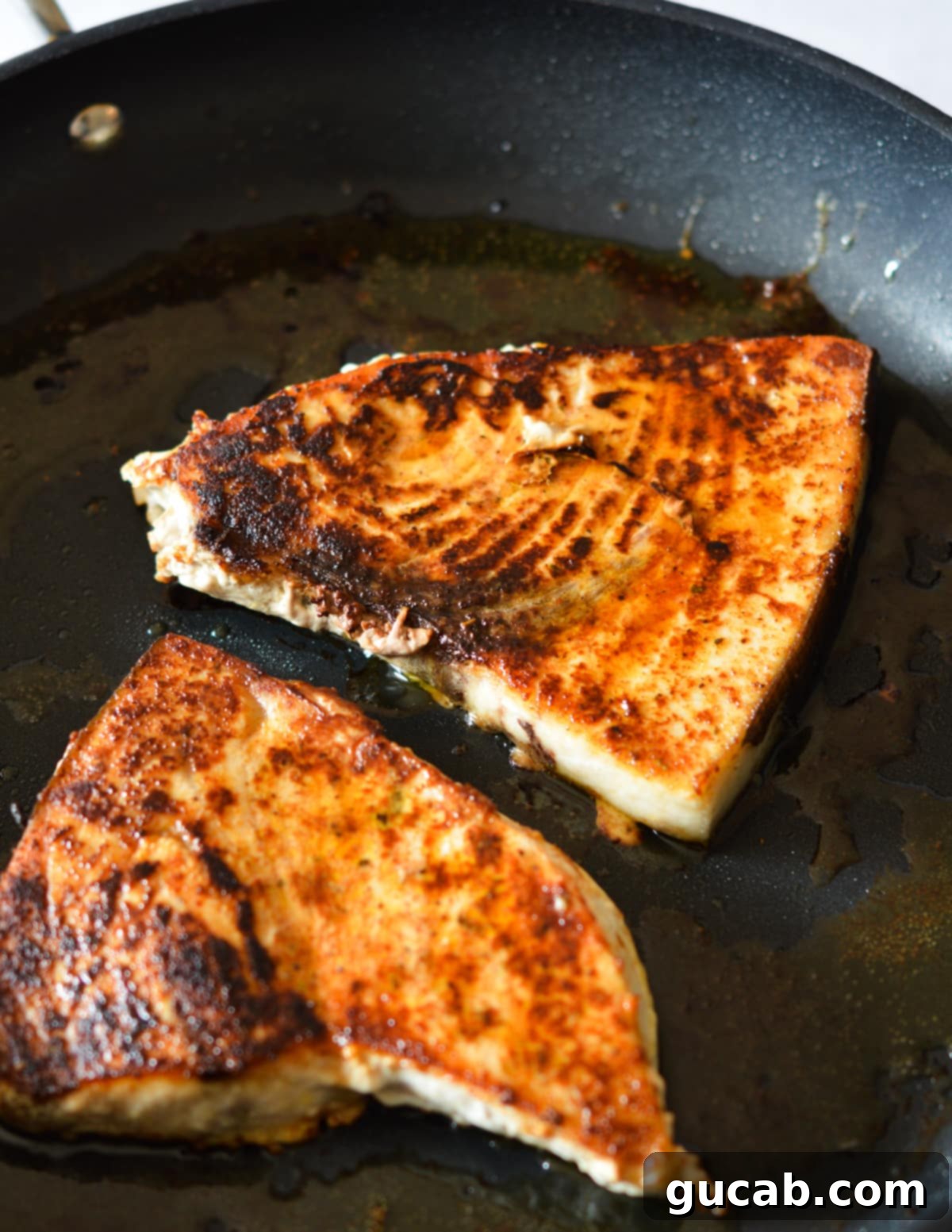
Using an oven mitt, carefully remove the hot skillet from the oven. Remember, the handle will be extremely hot! Transfer the succulent swordfish steaks to individual serving plates. Top each steak generously with two teaspoons of the freshly prepared Cajun butter. The butter will instantly begin to melt, creating a wonderful sauce. Serve immediately and savor every juicy bite!
Expert Recipe Tips for the Best Blackened Swordfish
To ensure your blackened swordfish turns out perfectly every time, keep these essential tips in mind:
- Don’t Move the Fish While Searing: This is perhaps the most critical rule for achieving a truly blackened and crispy crust. When the swordfish is placed in the hot skillet, allow it to remain in direct contact with the cooking surface for the full 5 minutes without moving or disturbing it. The longer it sits, the better the Maillard reaction will occur, leading to that deep, flavorful caramelization. Fiddling with it will disrupt this process and result in a less impressive sear.
- Avoid Overbaking at All Costs: Overcooked swordfish is dry, tough, and loses its delightful flavor. Pay close attention to the cooking time, especially if your steaks are thinner. Start with 8 minutes in the oven and check for doneness. The fish is ready when it turns opaque throughout and flakes easily with a fork. For a medium-cooked swordfish, an internal temperature of around 130°F (54°C) is ideal. A meat thermometer is your best friend here.
- Always Use an Oven Mitt for the Skillet Handle: It’s incredibly easy to forget that a skillet just came out of a hot oven. The handle will be searing hot! To prevent accidental burns, make it a habit to leave an oven mitt draped over the handle as a visual and tactile reminder that it’s hot to the touch. Safety first in the kitchen!
- Thaw Frozen Swordfish Completely: Attempting to pan-sear frozen or partially frozen swordfish will lead to unsatisfactory results. The exterior won’t sear properly, and the fish will cook unevenly, potentially leaving you with a raw center and an overcooked exterior. Always ensure your swordfish is fully thawed before beginning the cooking process.
- High Heat is Your Friend for Searing: Blackening relies on a very hot pan. Ensure your skillet is heated sufficiently over medium-high heat until it’s just smoking or a drop of water quickly sizzles and evaporates. This high heat quickly creates the crust and locks in moisture.
- Don’t Overcrowd the Pan: If cooking more than two steaks, it’s best to sear them in batches. Overcrowding the pan lowers the temperature of the skillet, which will steam the fish instead of searing it, preventing that beautiful blackened crust from forming.
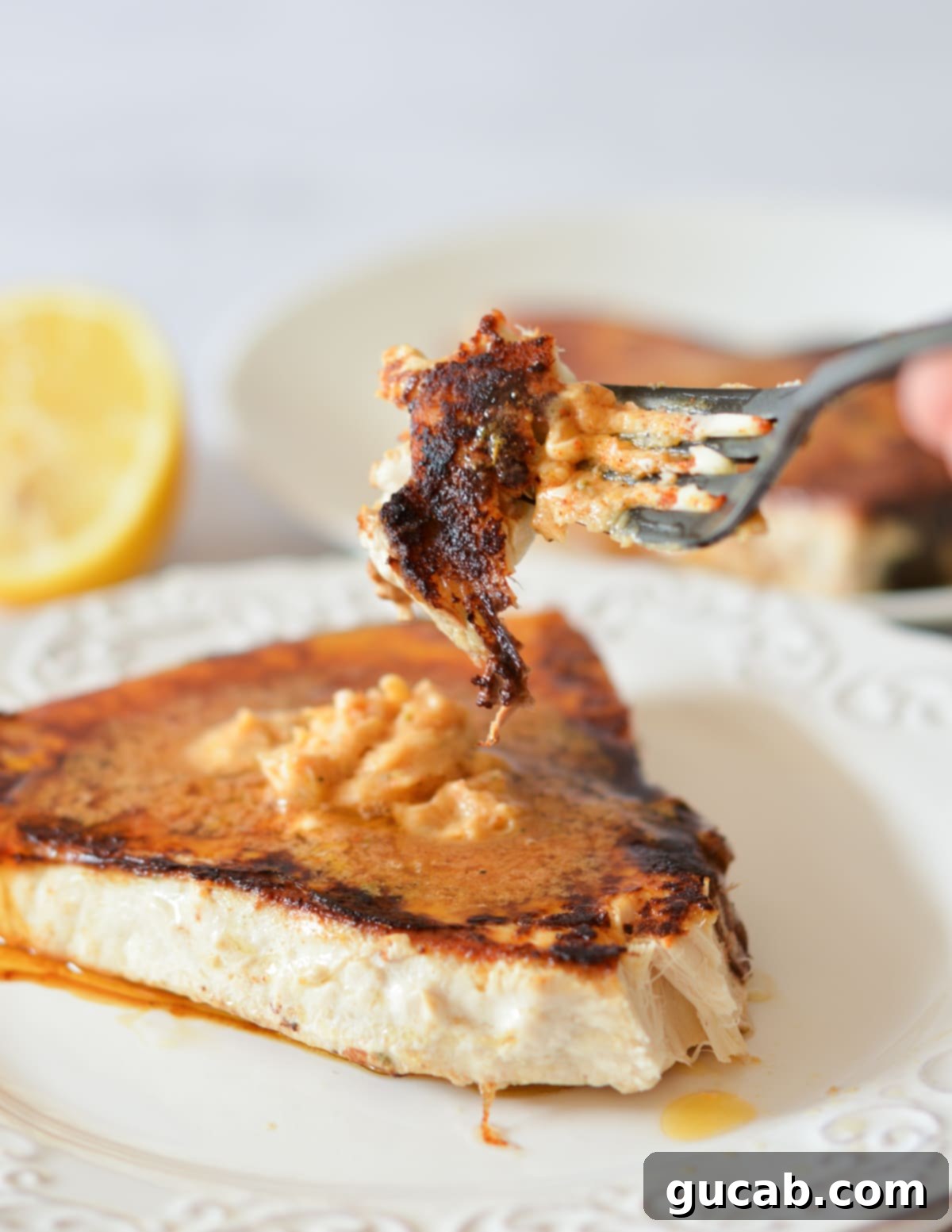
Delicious Variations to Customize Your Meal
While this blackened swordfish recipe is perfect as written, feel free to get creative and adapt it to your dietary needs or taste preferences:
- Dairy-Free Option: If you’re avoiding dairy, simply swap the unsalted butter for a high-quality dairy-free butter substitute. Ghee (clarified butter) also works wonderfully and adds a slightly nutty flavor while being lactose-free. Plant-based butter alternatives are widely available and perform excellently in compound butter recipes.
- Pre-Made Cajun Seasoning: For ultimate convenience, you can replace the individual spices with 1 ¼ teaspoons of your favorite store-bought Cajun or blackening seasoning mix. Be sure to check the ingredient list for salt content, as some mixes are very salty, and you might need to adjust the added kosher salt in the recipe accordingly. Brands like Tony Chachere’s or Slap Ya Mama are popular choices.
- Skillet Choice: I’ve used a nonstick skillet, which is great for easy cleanup. However, a cast iron skillet is truly exceptional for blackening. Cast iron retains heat incredibly well and creates an even more pronounced, crispier crust. Just ensure your cast iron skillet is well-seasoned to prevent sticking.
- Add More Heat: Love a fiery kick? Increase the amount of cayenne pepper in the spice blend, or add a pinch of dried chili flakes. For a fresh burst of heat, finely dice a small jalapeño or serrano pepper and mix it into the Cajun butter.
- Herbaceous Twist: Experiment with adding different fresh herbs to your Cajun butter. Finely chopped fresh parsley or chives can add another layer of fresh flavor and a beautiful pop of color.
- Citrus Variations: Instead of lemon, consider using lime zest and juice for a different citrusy tang that pairs beautifully with the Cajun spices.
- Smoky Enhancement: A tiny pinch of smoked paprika or a dash of liquid smoke in the spice blend can deepen the smoky notes, enhancing the “blackened” flavor profile.
Frequently Asked Questions (FAQs) About Blackened Swordfish
What is the dark spot on a swordfish steak?
Don’t be alarmed by a dark red or brownish area on your swordfish steak! This dark spot does not indicate that your swordfish is bad or spoiled. It’s actually a muscle that is very high in myoglobin, a blood pigment that carries oxygen, similar to what gives red meat its color. This muscle is perfectly safe to eat, although it typically has a slightly stronger, more pronounced flavor compared to the lighter, milder areas of the fish. If you prefer to avoid this stronger taste, you can simply trim it away before cooking, or opt for specific swordfish cuts rather than full steaks.
Can I grill blackened swordfish?
Absolutely! Blackened swordfish can be fantastic on the grill. Prepare your swordfish steaks as described, seasoning them generously. Preheat your grill to medium-high heat. Lightly oil the grill grates to prevent sticking, then grill for about 4-6 minutes per side, depending on thickness, until opaque and flaky. The high heat of the grill will give it a wonderful charred flavor similar to blackening in a skillet, and the Cajun butter will still be a perfect topping!
What should I serve with blackened swordfish?
Blackened swordfish pairs wonderfully with a variety of side dishes. For a classic Southern-inspired meal, consider serving it with creamy grits or dirty rice. Other excellent options include roasted asparagus, sautéed green beans, a crisp garden salad, corn on the cob, or a simple side of fluffy white rice to soak up that delicious Cajun butter. Roasted potatoes or sweet potato fries also make a great accompaniment.
Is swordfish a healthy choice?
Yes, swordfish is a very healthy choice! It’s an excellent source of lean protein, which is essential for muscle growth and repair. It’s also rich in omega-3 fatty acids, which are beneficial for heart health and brain function. Additionally, swordfish provides significant amounts of Vitamin D, selenium, and Niacin. As with any larger fish, it’s wise to consume it in moderation as part of a balanced diet due to potential mercury levels, but it remains a nutritious option.
Serving Suggestions for Your Blackened Swordfish
Once your perfectly cooked blackened swordfish is topped with its rich Cajun butter, you’ll want to pair it with sides that complement its bold flavors without overpowering them. Here are some fantastic suggestions to complete your meal:
- Rice or Grains: A simple bed of fluffy white rice, brown rice, or even quinoa is excellent for absorbing the melted Cajun butter and balancing the spice. For an authentic touch, consider serving with dirty rice or a classic New Orleans-style red beans and rice.
- Roasted Vegetables: Roasting brings out the natural sweetness in vegetables, which pairs wonderfully with the savory fish. Asparagus, broccoli, bell peppers, or zucchini tossed with a little olive oil, salt, and pepper and roasted until tender-crisp make a quick and healthy side.
- Fresh Salads: A light, crisp green salad with a vinaigrette dressing provides a refreshing counterpoint to the rich fish. A coleslaw, especially one with a vinegar-based dressing, also works beautifully.
- Corn Dishes: Corn complements Cajun flavors exceptionally well. Serve with grilled corn on the cob, a simple corn and black bean salsa, or a creamy corn succotash.
- Potatoes: Roasted baby potatoes, creamy mashed potatoes, or even sweet potato fries offer a comforting and hearty side.
- Crusty Bread: Don’t underestimate the power of a good piece of crusty French bread to sop up all the delicious pan juices and melted Cajun butter!
Storage and Reheating Blackened Swordfish
While blackened swordfish is best enjoyed fresh off the skillet, you can absolutely store and reheat leftovers. Proper handling will help maintain its quality:
- Storage: Allow any leftover swordfish to cool completely to room temperature (within 1-2 hours) before transferring it to an airtight container. Store it in the refrigerator for up to 2-3 days.
- Reheating: To reheat, the key is to do it gently to prevent the fish from drying out.
- Oven Method (Recommended): Preheat your oven to a low temperature, around 275-300°F (135-150°C). Place the swordfish on a baking sheet, cover it loosely with foil to retain moisture, and bake for 10-15 minutes, or until just warmed through.
- Skillet Method: Heat a small amount of olive oil or butter in a nonstick skillet over medium-low heat. Add the swordfish and cover the skillet. Cook gently for a few minutes per side until warmed through. Be careful not to overcook.
- Microwave (Last Resort): While possible, the microwave can often dry out fish. If using, reheat on a low power setting in short bursts (30-60 seconds) until just warm.
Adding a fresh dollop of Cajun butter (if you have extra) or a squeeze of fresh lemon juice after reheating can help revive the flavors and moisture.
More Delicious Seafood Recipes to Explore
If you loved this blackened swordfish, be sure to try these other fantastic seafood dishes that are just as easy to make and bursting with flavor:
- Lemon Pepper Salmon
- Seared Shrimp and Avocado Salad
- Juicy Pan-Seared Shrimp
Ready to experience a taste sensation that’s quick, healthy, and incredibly satisfying? This blackened swordfish with homemade Cajun butter is truly a game-changer for any seafood lover. Give it a try tonight and discover your new favorite way to prepare swordfish!

Blackened Swordfish with Cajun Butter
Carolyn Truett
Pin Recipe
5 minutes
13 minutes
18 minutes
Main Course
American
2
servings
473
kcal
Equipment
-
12-inch oven-safe skillet
Ingredients
-
2
swordfish steaks or select cuts -
2
tablespoons
olive oil -
¼
teaspoon
paprika -
¼
teaspoon
kosher salt -
¼
teaspoon
onion powder -
¼
teaspoon
garlic powder -
⅛
teaspoon
black pepper -
⅛
teaspoon
cayenne pepper -
⅛
teaspoon
oregano -
2
tablespoons
unsalted butter
softened -
½
lemon, zested -
1
teaspoon
lemon juice
Instructions
-
Preheat oven to 350 degrees Fahrenheit.
-
Heat a 12-inch nonstick or cast iron skillet over medium-high heat.
-
While the pan heats up, make the spice mixture. In a small bowl, combine the paprika, salt, pepper, cayenne, oregano, onion powder, and garlic powder. Mix with a spoon.
-
Dry the swordfish steaks with a paper towel, then sprinkle ¼ teaspoon of the spice mixture on top of each steak, coating the entire surface.
-
Add the olive oil to the hot skillet. Carefully place the steaks into the skillet, seasoned side down.
-
Let the steaks sear for 5 minutes. Do not move them.
-
Use a thin-set spatula to carefully turn the steaks over. Immediately place the skillet into the oven and bake for 8 to 10 minutes. When it’s opaque and flakes easily, it’s done!
-
While the swordfish cooks, make the Cajun butter. In a small bowl, mash the butter with the remaining spice mixture, lemon zest, and juice.
-
Use an oven mitt to carefully remove the hot pan from the oven. Do not touch the handle with your bare hands!
-
Use a thin set spatula to transfer the swordfish steaks to serving plates. Top each steak with two teaspoons of Cajun butter. Enjoy!
Nutrition
Calories:
473
kcal
Carbohydrates:
1
g
Protein:
34
g
Fat:
37
g
Saturated Fat:
12
g
Polyunsaturated Fat:
4
g
Monounsaturated Fat:
18
g
Trans Fat:
1
g
Cholesterol:
142
mg
Sodium:
431
mg
Potassium:
733
mg
Fiber:
0.4
g
Sugar:
0.2
g
Vitamin A:
629
IU
Vitamin C:
4
mg
Calcium:
18
mg
Iron:
1
mg
blackened swordfish
Tried this recipe?
Let us know how it was!
